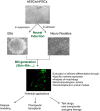Motor neuron derivation from human embryonic and induced pluripotent stem cells: experimental approaches and clinical perspectives
- PMID: 25157556
- PMCID: PMC4100331
- DOI: 10.1186/scrt476
Motor neuron derivation from human embryonic and induced pluripotent stem cells: experimental approaches and clinical perspectives
Abstract
Motor neurons are cells located in specific areas of the central nervous system, such as brain cortex (upper motor neurons), brain stem, and spinal cord (lower motor neurons), which maintain control over voluntary actions. Motor neurons are affected primarily by a wide spectrum of neurological disorders, generally indicated as motor neuron diseases (MNDs): these disorders share symptoms related to muscular atrophy and paralysis leading to death. No effective treatments are currently available. Stem cell-derived motor neurons represent a promising research tool in disease modeling, drug screening, and development of therapeutic approaches for MNDs and spinal cord injuries. Directed differentiation of human pluripotent stem cells - human embryonic stem cells (hESCs) and human induced pluripotent stem cells (hiPSCs) - toward specific lineages is the first crucial step in order to extensively employ these cells in early human development investigation and potential clinical applications. Induced pluripotent stem cells (iPSCs) can be generated from patients' own somatic cells (for example, fibroblasts) by reprogramming them with specific factors. They can be considered embryonic stem cell-like cells, which express stem cell markers and have the ability to give rise to all three germ layers, bypassing the ethical concerns. Thus, hiPSCs constitute an appealing alternative source of motor neurons. These motor neurons might be a great research tool, creating a model for investigating the cellular and molecular interactions underlying early human brain development and pathologies during neurodegeneration. Patient-specific iPSCs may also provide the premises for autologous cell replacement therapies without related risks of immune rejection. Here, we review the most recent reported methods by which hESCs or iPSCs can be differentiated toward functional motor neurons with an overview on the potential clinical applications.
Figures


References
-
- Mitne-Neto M, Machado-Costa M, Marchetto MC, Bengtson MH, Joazeiro CA, Tsuda H, Bellen HJ, Silva HC, Oliveira AS, Lazar M, Muotri AR, Zatz M. Downregulation of VAPB expression in motor neurons derived from induced pluripotent stem cells of ALS8 patients. Hum Mol Genet. 2011;20:3642–3652. doi: 10.1093/hmg/ddr284. - DOI - PMC - PubMed
-
- McDermott CJ, Shaw PJ. Diagnosis and management of motor neurone disease. BMJ. 2008;336:658–662. doi: 10.1136/bmj.39493.511759.BE. - DOI - PMC - PubMed
-
- Orrell RW. GPs have key role in managing motor neurone disease. Practitioner. 2011;255:19–22. - PubMed
-
- Lefebvre S, Burglen L, Reboullet S, Clermont O, Burlet P, Viollet L, Benichou B, Cruaud C, Millasseau P, Zeviani M, Le Paslier D, Frézal J, Cohen D, Weissenbach J, Munnich A, Melki J. Identification and characterization of a spinal muscular atrophy-determining gene. Cell. 1995;80:155–165. doi: 10.1016/0092-8674(95)90460-3. - DOI - PubMed
Publication types
MeSH terms
Substances
LinkOut - more resources
Full Text Sources
Other Literature Sources

